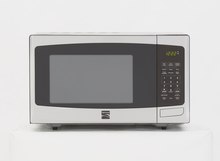LG Microwave Ovens
A microwave oven (commonly referred to as a microwave) is an electric oven that heats and cooks food by exposing it to electromagnetic radiation in the microwave frequency range.[1] This induces polar molecules in the food to rotate and produce thermal energy in a process known as dielectric heating. Microwave ovens heat foods quickly and efficiently because excitation is fairly uniform in the outer 25–38 mm (1–1.5 inches) of a homogeneous, high water content food item.
The development of the cavity magnetron made possible the production of electromagnetic waves of a small enough wavelength (microwaves). American engineer Percy Spencer is generally credited with inventing the modern microwave oven after World War II from radar technology developed during the war. Named the "Radarange", it was first sold in 1946. Raytheon later licensed its patents for a home-use microwave oven that was first introduced by Tappan in 1955, but these units were still too large and expensive for general home use. Sharp Corporation introduced the first microwave oven with a turntable between 1964 and 1966. The countertop microwave oven was first introduced in 1967 by the Amana Corporation. After Sharp introduced low-cost microwave ovens affordable for residential use in the late 1970s, their use spread into commercial and residential kitchens around the world. In addition to their use in cooking food, microwave ovens are used for heating in many industrial processes.
Microwave ovens are a common kitchen appliance and are popular for reheating previously cooked foods and cooking a variety of foods. They are also useful for rapid heating of otherwise slowly prepared foodstuffs, which can easily burn or turn lumpy when cooked in conventional pans, such as hot butter, fats, chocolate or porridge. Unlike conventional ovens, microwave ovens usually do not directly brown or caramelize food, since they rarely attain the necessary temperatures to produce Maillard reactions. Exceptions occur in rare cases where the oven is used to heat frying-oil and other very oily items (such as bacon), which attain far higher temperatures than that of boiling water.
Microwave ovens have limited roles in professional cooking,[2] because the boiling-range temperatures of a microwave will not produce the flavorful chemical reactions that frying, browning, or baking at a higher temperature will. However, additional heat sources can be added to microwave ovens.
Microwave ovens use electronic circuit boards and single chip micro computers, with the help of heat and humidity sensors, to control how your food is cooked. Newer light weight microwave ovens use an electronic inverter power supply to create the high voltage necessary to drive the magnetron. As with most modern electronic circuits they sometimes fail and your microwave oven doesn't work as it is supposed to. Our technicians at Townsville Electronics are trained in electronic circuit fault diagnosis and can repair your microwave oven to good working order,
There are no products to list in this category.


